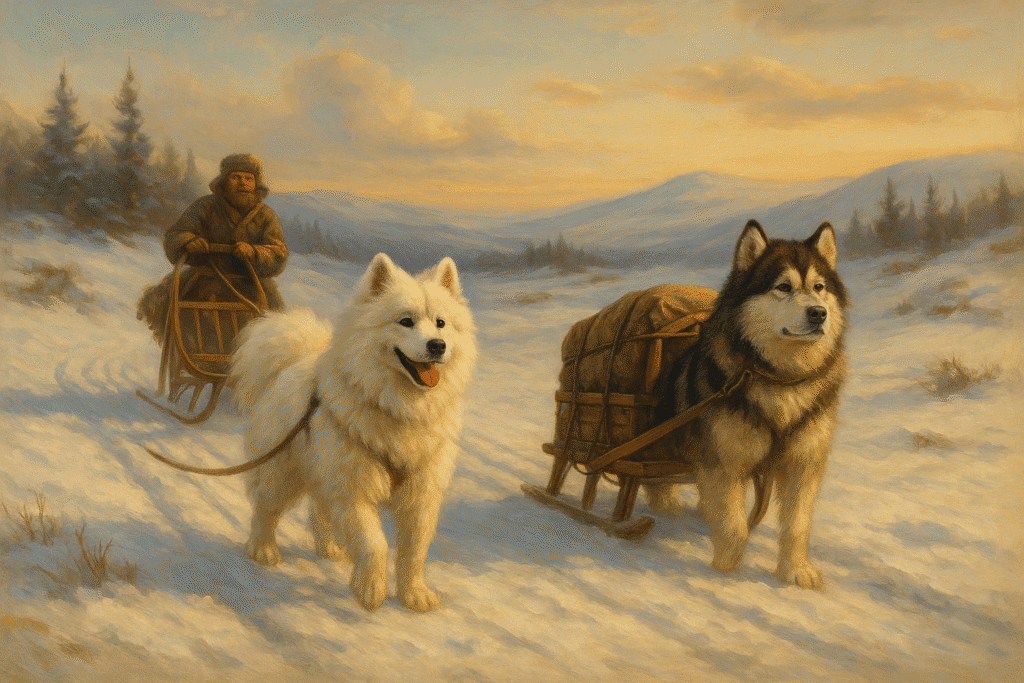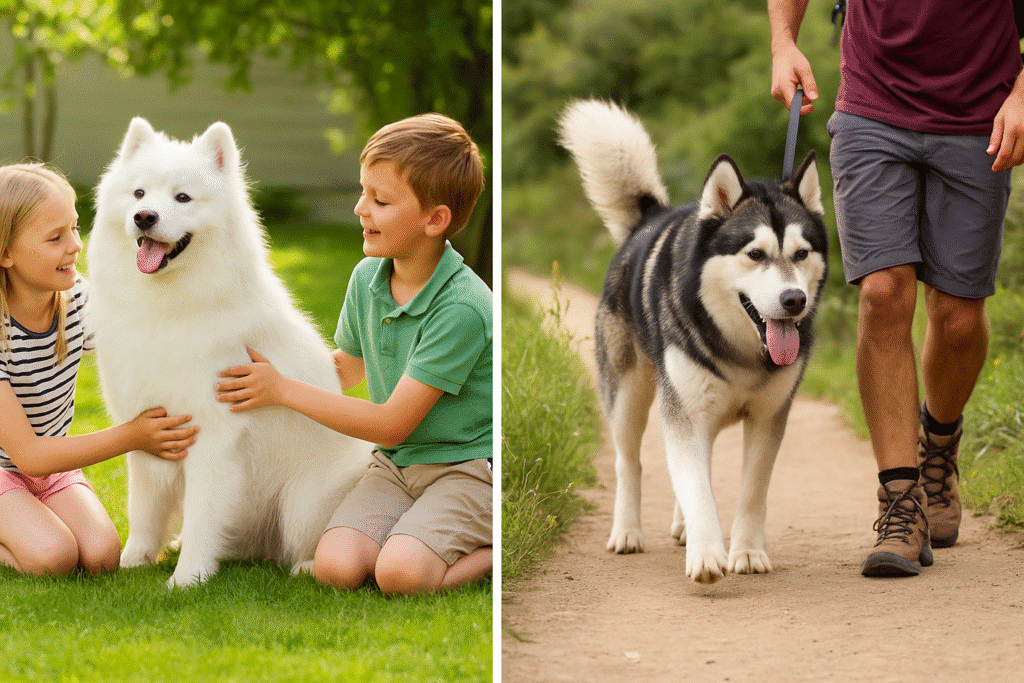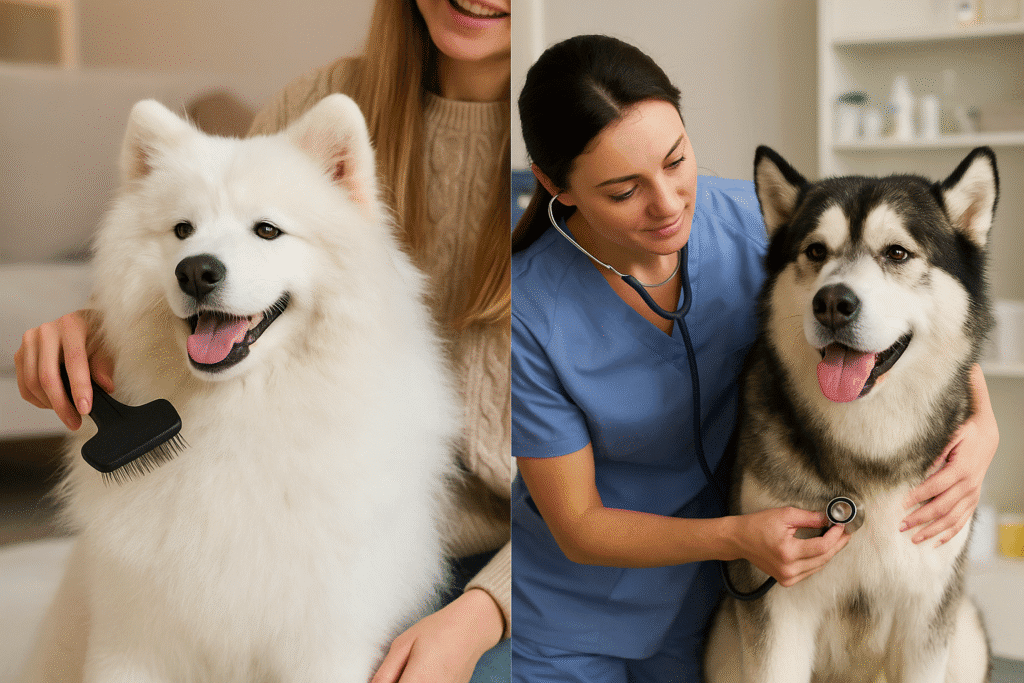This Samoyed vs Alaskan Malamute guide highlights key differences in personality, grooming, and health. Discover which northern breed suits your lifestyle best, from their affectionate temperaments to exercise demands and care needs. Make an informed choice before welcoming one of these majestic dogs into your home.
Introduction
Choosing between the Samoyed vs Alaskan Malamute is no easy task. Both are powerful northern breeds with thick coats and captivating personalities. However, they differ in important ways—from energy levels and grooming requirements to health challenges and temperament. This guide compares the two to help you decide which breed fits your lifestyle best.

(Outbound link: Learn more about breed standards at American Kennel Club: Dog Breeds.)
Breed Origins and History
Samoyed: The Smiling Sled Dog
Samoyeds originated with the Samoyedic people of Siberia, where they were used for herding reindeer, pulling sleds, and keeping families warm at night. Known as the “smiling dogs,” they are famous for their friendly expressions and affectionate nature.
Alaskan Malamute: The Arctic Powerhouse
Alaskan Malamutes were bred by the native Mahlemut people of Alaska. They were developed for hauling heavy loads over long distances. Malamutes are among the strongest Arctic sled dogs, known for their endurance and loyalty.
Appearance: Samoyed vs Alaskan Malamute
While both breeds share fluffy double coats and wolf-like appearances, there are noticeable differences:
- Samoyed: Medium to large-sized, with a white, fluffy coat and the signature “Sammy smile.”
- Alaskan Malamute: Larger and more powerful, with a dense coat in shades of gray, black, sable, or red, often with facial masks.
(Internal link: Compare coat care with our Samoyed Dog Care Guide.)
Personality and Temperament
Samoyed Personality
Samoyeds are affectionate, social, and thrive on human companionship. They are often described as gentle, playful, and adaptable. This makes them excellent family pets, especially with children.
Alaskan Malamute Personality
Malamutes are loyal, independent, and protective. They can be more stubborn than Samoyeds and require firm but kind training. While loving with family, they may be less outgoing with strangers compared to Samoyeds.

Exercise Needs
Both breeds are highly active, but their needs differ slightly:
- Samoyed: Requires daily exercise, including long walks and play sessions. They enjoy moderate challenges like agility or hiking.
- Alaskan Malamute: Needs intense physical activity such as running, sledding, or backpacking. They are working dogs and require a job to stay mentally and physically satisfied.
Grooming and Coat Care
Both breeds shed heavily, especially during seasonal coat blows.
- Samoyed: Requires frequent brushing (3–4 times weekly) to prevent matting. Their coats stay relatively clean and resist dirt.
- Alaskan Malamute: Needs brushing at least 2–3 times weekly. Their dense coat can mat if neglected, and seasonal shedding is significant.
(Outbound link: See grooming basics from AKC: How to Groom a Dog.)
Health Considerations
Samoyed Health
Common issues include hip dysplasia, progressive retinal atrophy, and diabetes. Regular vet checkups and genetic screening are crucial.
Alaskan Malamute Health
They are prone to hip dysplasia, hypothyroidism, and inherited polyneuropathy. Their large size also makes them vulnerable to joint problems as they age.
(Internal link: Learn more in our Managing Arthritis in Dogs Guide.)
Training and Intelligence
Both breeds are intelligent but have different learning styles:
- Samoyed: Eager to please, responds well to positive reinforcement.
- Alaskan Malamute: Intelligent but independent, requiring consistent, firm training.
(Internal link: For recall techniques, read our Recall Training Guide.)
Living Environment
Both breeds prefer cooler climates due to their dense coats. They thrive in homes with large yards and active families. Apartments are challenging unless owners are committed to providing substantial exercise.
Which Breed Is Right for You?
- Choose a Samoyed if you want a sociable, affectionate companion with slightly easier trainability.
- Choose an Alaskan Malamute if you prefer a powerful, loyal working dog who thrives on intense exercise and strong leadership.

Frequently Asked Questions (FAQ)
- Are Samoyeds or Malamutes better with kids?
Samoyeds are typically more playful and gentle with children, while Malamutes can be great family dogs but need supervision with smaller kids due to their size. - Do Samoyeds bark more than Malamutes?
Yes, Samoyeds are known for being vocal, while Malamutes are quieter but may howl. - Which breed needs more grooming?
Both need significant grooming, but Samoyeds often require more frequent brushing to keep their white coats pristine. - Can either breed live in hot climates?
They can adapt with proper care, but both breeds are far more comfortable in cooler environments. - Which breed is more independent?
Malamutes are generally more independent and stubborn compared to the people-oriented Samoyed.
Conclusion
The choice between Samoyed vs Alaskan Malamute depends on your lifestyle and expectations. Both breeds are majestic, intelligent, and deeply loyal, but their care and personalities differ. By understanding these differences, you can choose the companion that will thrive best in your home.
Call to Action
Want to learn more about dog breeds? Explore our Dog Breeds section here.

